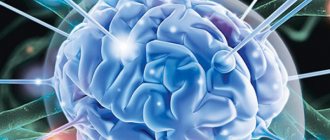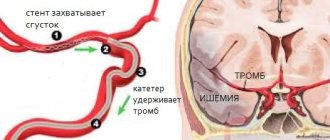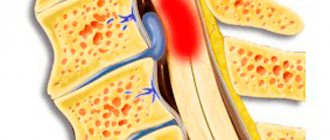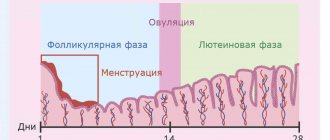Deterioration of cerebral vascular tone often occurs even in completely healthy people. The general condition and well-being of a person is directly related to the activity of the brain.
It is necessary to use medications only as prescribed by a doctor and not as a priority.
The first thing you should try is physical techniques and exercises to improve blood circulation in the brain. They help free blood vessels from various pinches.
Indications for therapeutic exercises
In case of cerebrovascular accidents, doctors often diagnose vegetative-vascular dystonia.
Symptoms of this condition include:
- headaches;
- dizziness;
- increased blood pressure, tachycardia;
- feeling of lack of air;
- disorders in the gastrointestinal tract;
- noise in ears;
- nausea;
- feeling exhausted and tired;
- loss of consciousness;
- sleep problems and other ailments.
The listed phenomena are indications for therapeutic exercises. Among the methods of therapy and prevention, proper physical activity and exercises, breathing techniques, and relaxation are recommended.
People whose work involves sitting for long periods of time need to do physical exercise to prevent negative symptoms.
What is dementia
With the development of dementia, a person’s mental abilities decrease, existing knowledge and skills are gradually lost, and the ability to learn is lost.
Thinking, orientation, understanding, counting, learning, language and judgment are impaired. There are many reasons why dementia develops. Dementia can be triggered by endocrine and vascular pathologies, depression, certain infections, traumatic brain injuries, brain tumors, alcoholism and drug addiction. Additional risk factors for developing dementia include:
- heredity. Moreover, the risk increases if the pathology in close relatives developed before the age of 65 years;
- obesity;
- lack of active intellectual activity.
Principles and technique of execution
There is no need to have any special skills in order to perform exercises to improve blood circulation. Such gymnastics does not require excessive expenditure of effort.
The following exercises will help eliminate vascular spasms:
- You need to stand up straight with your feet shoulder-width apart. For two to three minutes, slowly turn your head first to the right, then to the left. While in the same position, extend your arms up and cross your fingers. Bend forward 7-8 times. The movements of your arms and body should resemble actions as if you were chopping wood.
- In the above position, you need to straighten your arms at chest level. Swing your leg diagonally. The leg should rush towards the hand from the opposite edge. Then repeat the swing with the other leg.
- Lying on your back, extend your arms to your sides. An exercise to lift the lower limbs is performed. The knee areas remain unbending. After repeating the lifts 8-10 times, you need to complete the technique with a stand on your shoulder blades. The legs and pelvis are raised and fixed in an inverted vertical position of the body. The palms rest on the back, and the elbow area on the floor. You need to hold in this position for one to three minutes.
There are many useful exercises for the head in yoga practice. To perform, you need a special favorable moral attitude and relaxation, the absence of disturbing thoughts.
For headaches caused by shoulder tension, you need to do the following exercise: sit on the floor in a position in which there is a small space between your shins, with your shins parallel to each other. You need to clasp your hands behind your back and make smooth bends forward. The tilt occurs with the head touching the floor. Do 5-6 such bends, not forgetting about deep breathing. A slight stretch should be felt in the chest, shoulders and neck.
To eliminate tension in the back, neck, head and shoulders, it is recommended to take the following position:
Do not place your hands in this position too far or wide from your back. Fix your body in this position for 5-7 seconds or longer.
Alexander Zakurdaev, student and co-author of Professor I. P. Neumyvakin, advises the following fairly simple exercises to improve blood circulation in the brain:
- To warm up, stand in the standard pose “feet shoulder-width apart” and raise your shoulders up and down 5-7 times, as if demonstrating the “I don’t know” gesture.
- Next, place your chin on your chest and with the next movement, tilt your head back. Everything happens smoothly, you don’t have to throw your head back too far.
- Turns the head to the right and left while controlling the position of the eyes. The line that passes in front of the eyes should be parallel to the floor. Turns are made 6-8 times.
- Tilts the head to the right and left.
- Rolling the head first in one direction, then in the opposite direction. The chin is placed on the chest and a smooth roll of the head is performed. 3-4 times in one direction, and the same in the other.
- Grab your hands one at a time in front of you and turn left and right 6-7 times.
For tinnitus, the following technique is recommended. Place a clean pencil or pen in your mouth. Mentally imagine the numbers in front of you and draw their image in the air with a pen. You need to try to “depict” as large and voluminous numbers as possible, moving your neck in opposite directions. Movements can be made directly while working at your desk.
A series of exercises for noise in the head and ears:
- take your ears in your hands and open your mouth strongly;
- grab the uppermost area of the ear and pull it up, repeating 4-6 times on one and the other ear;
- stretching your ears, move your jaw left and right;
- pull back the ears and quickly release them, repeating 4-5 times;
- close your mouth and repeat the series of exercises 2-3 times.
Strengthening the blood vessels of the legs - a confident step into a healthy life
The “payback” for walking upright is the increased load experienced by the veins of the legs. Weakness of the leg veins can lead to stagnation of blood, and as a result, serious damage to the veins. There is no better way to prevent vascular diseases in the legs than movement. To reduce the load on the lower limbs, it is more effective to perform exercises in water. Swimming, water aerobics, taking balneological baths and even simply pouring cool water on your feet stimulates blood circulation and causes the blood vessels in your legs to contract and unclench with greater intensity. Such regular exercise for the vessels helps to strengthen them and makes the walls of the leg veins more elastic.
A set of exercises aimed at strengthening the blood vessels of the legs
- I.P. – standing on the floor, feet wider than shoulders. Bend forward and down, reaching the floor surface with your fingers. When performing bends, keep your legs straight.
- I.P. - sitting on the floor. Spread your legs as wide as possible, fold your arms at chest level, leaning forward to reach the floor with bent arms. Make sure your legs remain straight. After every 8-10 bends, take a minute break.
- I.P. - on my knees. Stretch your arms to the sides and start walking on your knees back and forth. If you are tired, lie down on the floor and restore your breathing.
Exercises to prevent venous insufficiency of the legs and varicose veins
Slow jogging is useful for improving the health of blood vessels in the legs. If you approach training without excessive fanaticism, dosing the intensity of the load and the duration of runs, then the benefits will be undoubted. Contraindications for training may include:
- Eating shortly before a run;
- Noise or buzzing in the ears;
- Weakness in the legs;
- Severely reduced blood pressure.
If you experience excessive fatigue or discomfort while jogging, it is better to stop, do a few breathing exercises to restore your breathing, and start walking. The intensity of training should be increased only when the body fully adapts to the increased physical activity.
Video: preventative exercises for legs
Neck exercises
Neck training also relieves headaches and activates blood circulation in the brain:
- The “Stretching” method is performed while sitting with a straight back. The lower limbs are placed on the floor, and the hands are placed on the surface or on the thighs. The neck is in a straight position, and the back of the head is slightly raised up. The chin slowly moves downwards without touching the sternum. The shoulders are relaxed, they need to be lowered a little lower. Do it 3-4 times. You should feel a slight stretch in the neck area.
- In the same position with relaxed shoulders and arms (they can be lowered a little lower), slowly bend your right ear to your right shoulder, then to the other side. In this case, the skull does not need to be tilted forward or backward; the shoulders are in a lowered position. You need to stretch with the ear to the shoulder, and not the shoulder to the ear.
- The starting position is the same. In a sitting position, the chin area smoothly lowers and presses against the neck area. At the same time, you cannot open your mouth, and your back and neck should be straight. Fix in this position for a few seconds. Repeat 3-4 times.
- “Image of circles” is a simple circular rotation of the head in different directions. Use with caution for those who have osteochondrosis or pain in the neck and back. You can “depict” the number eight with your head movements.
Breathing exercises
Taoist and Thai breathing exercises are not recommended to be done immediately after eating or drinking. It is recommended to exercise on an empty stomach.
Holding your breath activates cerebral circulation and purifies the blood entering the brain. To perform this, sit comfortably in front of a mirror and hold your breath for the maximum number of seconds. If you experience unpleasant or painful sensations, redness of the face and a feeling of pulsation in the temporal region, you cannot continue the technique.
Taoist teachings advise performing the following exercise during a period of solitude and calm: lying on a soft, comfortable bed in a comfortable position, close your eyes and hold your breath.
The “Smelted Air” technique is recommended to be carried out in loose clothing or completely naked. In a comfortable position, lying in bed, you need to stretch your arms and legs and relax. After taking a deep breath, you should hold your breath for the maximum amount of time. Next, you need to open your mouth and smoothly release the air in small “portions.” It is not recommended to do the exercise every day; it is advisable to take breaks of 5-6 days.
The initial position of the “Fetal Breathing” technique is the same - lying in a comfortable bed. Take a deep breath, after which the air is not released for 120 heart beats. Next, gently exhale slowly through your mouth. Inhalations and exhalations should be quiet and relaxed, so that the feather placed at the nose or mouth does not move. You should inhale more air and exhale less. After performing this technique 5-10 times, you need to gradually increase the pauses between inhalation and exhalation to 700 heart beats.
Breathing exercises according to Neumyvakin:
First signs of dementia
- Both long-term and short-term memory are impaired. It becomes difficult for a person to remember events that happened recently or remember new information.
- A person loses the skills of orientation in space and time. It is not uncommon for patients to become lost even in areas familiar to them.
- Indifference to once-loved activities appears, and the desire to learn new things disappears. This happens because the brain is no longer able to receive and process information.
- Reducing the criticality of one's own perception. Usually this symptom appears when planning the next period of life.
- In the future, both the progression of these symptoms and the appearance of others, more powerful in their effects, are noted. One of the clear hallmarks of dementia is that a person lives in his past.
At the earliest manifestations of the disease, it is important to promptly consult a therapist or general practitioner. If necessary, he will refer the patient to a specialist (neurologist, psychiatrist or geriatrician).
Strengthening capillaries - Nishi technique
From breath-holding techniques, you can move on to air-holding techniques along with physical exercises. Katsuzo Nishi described the following technique: starting position: standing, pressing the pads of your thumbs to your nostrils.
In this way, breathing is blocked. Next, bending the body parallel to the floor, the hip and knee areas bend, combined with air retention in the lungs. After this, you should take a break for a few minutes and repeat the technique 4-5 times. Must be performed before meals.
Gymnastics for cerebral atherosclerosis
People with atherosclerosis of the heart and brain, when starting to perform techniques, should remember that overload is contraindicated for them. The heart rate should not be more than 35-40 percent of normal. That is, if in normal condition the pulse is 110 beats per minute, then after exercise it should not exceed 140 beats.
Gymnastics for atherosclerosis helps improve the elasticity of the circulatory system and improve heart function.
Performed at least 2-3 times every 7 days:
- You should start doing gymnastics by repeating the methods for stretching - lying in bed, stretch your arms up, then left and right, repeating 6-7 times with your right hand, then the same amount with your left, then with both at once. After this, you need to pull your toes towards you and away from you, and make circular movements with your legs.
- Starting position - lying on your back, arms along the body, legs inseparable. Taking your arms in different directions, inhale. Then, gently pressing the lower lateral sections of the chest with your hand, exhale.
- Starting position: lying on your back, arms along your body, a small distance between your legs. Clench and unclench your toes 6-7 times. Perform rotational movements in the area of the ankle joints 5 times to the left and 5 times to the right. Breathe freely.
- Starting position: standing, turning sideways to the chair. Legs are closed. Leaning on the back of the chair with your left hand, swing your right leg 5-6 times. If you feel pain, stop the exercise.
Motor rehabilitation after stroke
The main method of rehabilitation of patients after a stroke with movement disorders (paresis, impaired coordination and statics) is physical therapy. Its tasks include full or partial restoration of range of motion, strength and dexterity in paralyzed limbs, balance function in ataxia, and self-care skills.
In the rehabilitation clinic, in addition to exercise therapy, patients are prescribed electrical stimulation of the neuromuscular system of paralyzed limbs and are given classes using the biofeedback method. Physical therapy exercises begin as soon as the patient regains consciousness and improves his general condition. At first it is passive gymnastics. Movements in all joints of the limbs are performed not by the patient, but by the exercise therapy instructor or relatives instructed by him. The patient is taught breathing exercises. Exercises are carried out under the control of pulse and blood pressure with mandatory pauses for rest.
In the future, the exercises become more complicated, the patient begins to sit down, and then is taught to sit down independently and get out of bed. The timing of patient activation is determined by many factors:
- severity of stroke (size of infarction or hemorrhage, dislocation of brain structures, amount of edema);
- general condition of the patient;
- severity of paresis;
- hemodynamic state.
Some patients begin to get up from the 3-5th day after a stroke, in other cases they begin to become active after 2-3 weeks. An important stage of rehabilitation is learning to stand and walk. In patients with severe paresis of the lower limb, this stage is preceded by an imitation of walking while sitting in a chair or lying in bed. The patient learns to stand first with the support of a rehabilitation therapist, then independently, holding onto the headboard or bedside frame. At the same time, it evenly distributes body weight onto the healthy affected leg.
Subsequently, the patient learns to walk. Start by walking in place. Then the patient walks around the ward supported by a bedside frame, then learns to walk independently using a three-legged or four-legged cane. With good stability, the patient is immediately taught to walk using a stick.
Only with good balance and moderate or mild paresis of the leg can the patient begin to walk independently without relying on a stick. The volume of movements and distance gradually increase: the patient first walks around the ward or apartment, then along the corridor and up the stairs. After this, he can go outside and use transport.
Some patients with mild impairments “skip” many stages of rehabilitation and immediately begin to walk independently over relatively long distances, while others stop at certain stages. When a paralyzed foot drops, patients are recommended to wear shoes with high, rigid fastenings. To prevent stretching of the shoulder joint bursa in a patient with severe paresis of the arm while walking, it is recommended to fix the arm with a scarf, removing it during exercise therapy.











